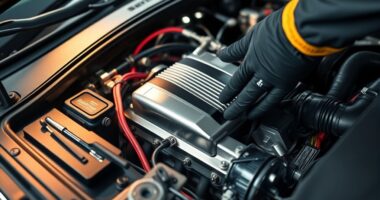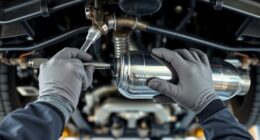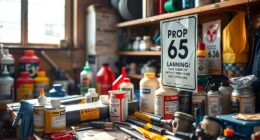To tune your car for optimal performance, start by upgrading the ECU software to optimize fuel and ignition timing, improving throttle response and power. Enhance airflow with high-quality intake and exhaust systems, and fine-tune suspension for better handling. Adjust transmission shift points and consider turbo upgrades for more boost. Regular maintenance guarantees all components work smoothly. Want to release even more from your car? Keep going, and you’ll discover how to maximize your ride’s potential.
Key Takeaways
- Remap or reprogram the ECU to optimize fuel delivery, ignition timing, and boost settings for better horsepower and throttle response.
- Upgrade intake and exhaust systems to improve airflow, including high-flow filters, headers, and tuned mufflers.
- Enhance handling and stability by upgrading suspension components, lightweight wheels, and performing proper wheel alignment.
- Fine-tune transmission shift points, gear ratios, and install performance clutches or torque converters for smoother power transfer.
- Regular maintenance such as oil changes, air filter replacements, and system inspections ensures modifications perform safely and reliably.
Upgrading the Engine Control Unit (ECU) for Power Gains
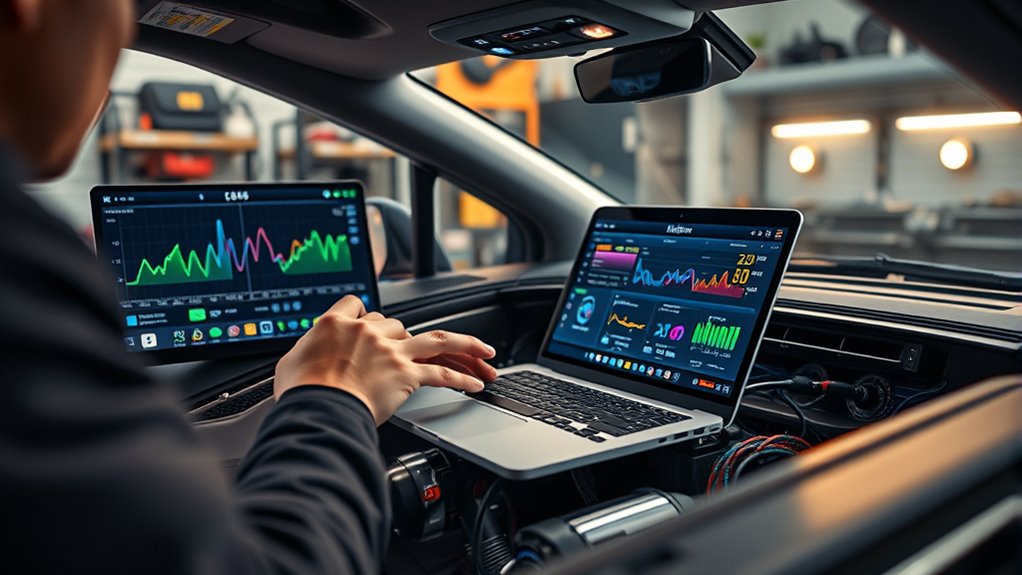
Upgrading your car’s Engine Control Unit (ECU) is a popular way to boost performance without adding mechanical parts. It involves modifying the software inside the ECU to optimize engine functions like fuel delivery and ignition timing. Pros of ECM Upgrades By uploading a new, tuned software file, you can release increased horsepower and torque, making your vehicle more responsive and powerful. This process enhances throttle response and can even improve fuel efficiency, saving you money in the long run. The ECU manages vital control functions, including spark timing, fuel injection, and turbo boost, so adjusting these settings can considerably impact performance. Proper remapping tailored to your vehicle ensures you get the best gains without risking engine damage, making it a cost-effective upgrade for enthusiasts. Additionally, Mazda tuning specialists can customize ECU maps to suit specific models and driving preferences, further maximizing your vehicle’s potential. As technology advances, the integration of automated tuning tools can help refine these adjustments for optimal results.
Enhancing Air Intake and Exhaust Systems for Better Breathing
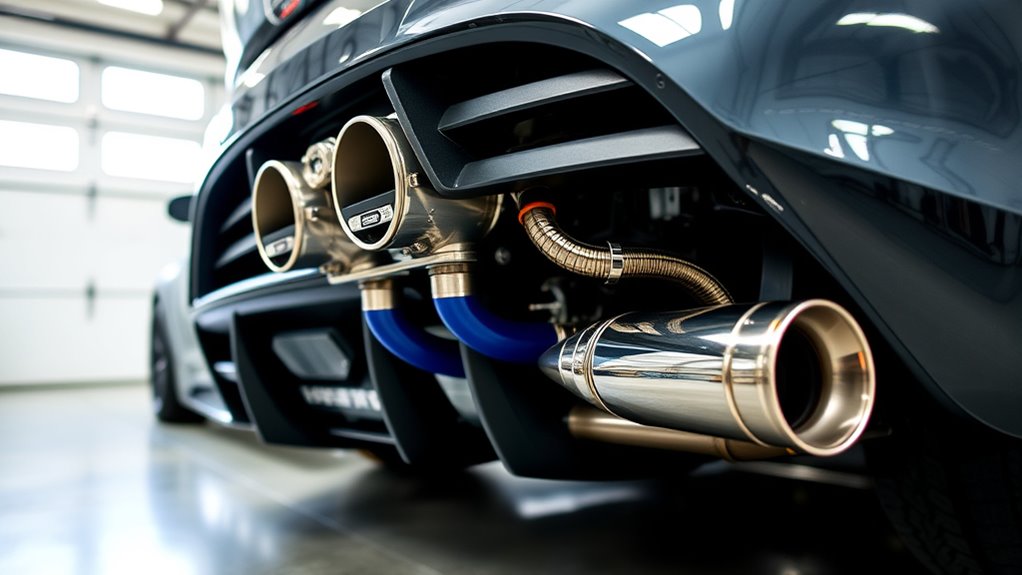
Improving your car’s air intake and exhaust systems is essential for allowing your engine to breathe more freely and operate more efficiently. Upgrading these components boosts airflow, which enhances power, throttle response, and fuel efficiency.
Enhancing your air intake and exhaust systems boosts engine efficiency and performance.
To achieve this, consider installing high-performance air filters that improve airflow while blocking debris, or cold air intake systems that draw in cooler, denser air for better combustion. Guarantee intake manifolds and ducts are smooth to reduce resistance, and calibrate the MAF sensor for precise air measurement. 1-D gas dynamics simulation enables effective evaluation of different intake and exhaust designs, ensuring optimal noise reduction and performance.
On the exhaust side, use high-quality headers to lower backpressure, optimize exhaust pathways for better gas scavenging, and fine-tune muffler designs for improved flow and sound control. Regular maintenance of these systems keeps airflow optimized and engine performance at its peak.
Optimizing Fuel and Throttle Settings for Responsiveness
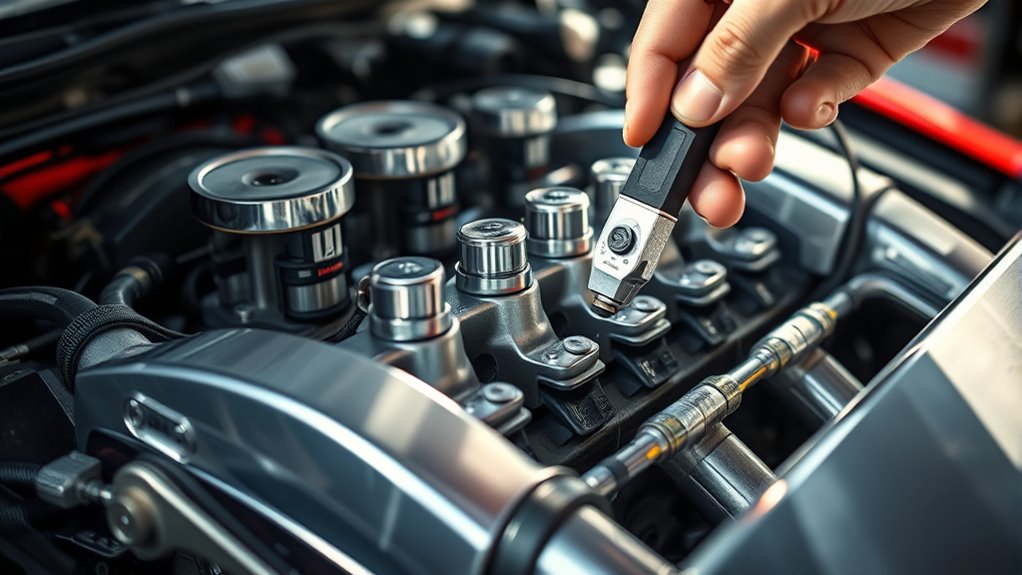
Enhancing your car’s fuel and throttle settings is crucial to achieving quicker, more responsive acceleration. By installing aftermarket throttle response controllers, you eliminate lag and fine-tune pedal-to-throttle ratios, improving immediate power delivery. Regular throttle body maintenance, like cleaning and calibration, ensures proper airflow and sensor accuracy. Upgrading to oversized throttle bodies can boost airflow for high-performance needs. Adjusting ECU parameters through reprogramming reduces input delay and refines throttle response. Combining these steps with fuel system upgrades—such as high-flow pumps and cleaner injectors—ensures consistent pressure and ideal fuel delivery during rapid acceleration. Proper maintenance of throttle components and air filters supports optimal airflow and response, which further enhances overall throttle responsiveness and engine performance. Additionally, performance tuning can optimize engine behavior for better responsiveness and efficiency. Focusing on sensor calibration can further refine throttle response by ensuring that all components work harmoniously.
Improving Suspension and Handling for Better Control

Enhancing your car’s suspension and handling capabilities is essential for gaining better control on the road. Upgrading components like shocks, springs, and bushings helps maintain constant tire contact, improving handling and stability. Proper wheel alignment is crucial after suspension modifications to ensure handling gains are fully realized and tire wear is minimized. Proper weight distribution from a quality suspension system also boosts ride comfort and responsiveness. To refine your setup, consider:
- Installing lowering springs for improved stance and cornering
- Upgrading shocks and struts to absorb road imperfections better
- Replacing control arms and bushings for enhanced alignment and stability
- Upgrading sway bars and links to reduce body roll during turns
These modifications increase performance, safety, and comfort. By choosing quality parts and testing your adjustments, you’ll optimize handling and gain a more confident driving experience. Proper suspension tuning is key to unblocking your vehicle’s full potential and ensuring vehicle safety during high-performance driving.
Fine-Tuning Transmission and Drivetrain Components
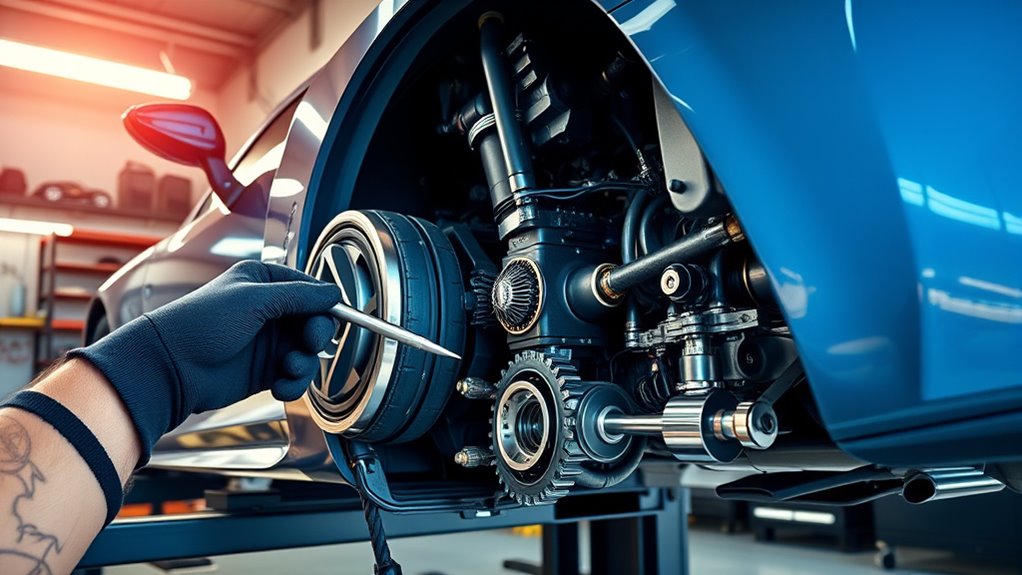
Fine-tuning your transmission and drivetrain components can substantially boost your vehicle’s performance and reliability. Start by optimizing shift points based on torque and engine speed to ensure smooth, efficient gear changes. Use tuning software to customize shift maps for different driving modes, like sport or economy, and balance shift points across gears for a seamless power transfer. Properly managing shift timing can also enhance the overall driving experience and extend transmission lifespan. Adjust gear ratios to enhance acceleration or top-end speed, depending on your goals. Manage torque converter lockup points to improve fuel efficiency and reduce wear, while meticulously adjusting torque distribution during shifts to prevent harsh engagements. Upgrading clutch packs, gear sets, and transmission fluids can further improve shift firmness and durability. Incorporating advanced cooling systems helps prevent overheating during aggressive driving and prolongs component life. Installing auxiliary coolers and strengthening driveshafts help handle increased power, ensuring your drivetrain remains reliable during aggressive driving.
Reducing Weight and Improving Aerodynamics for Efficiency
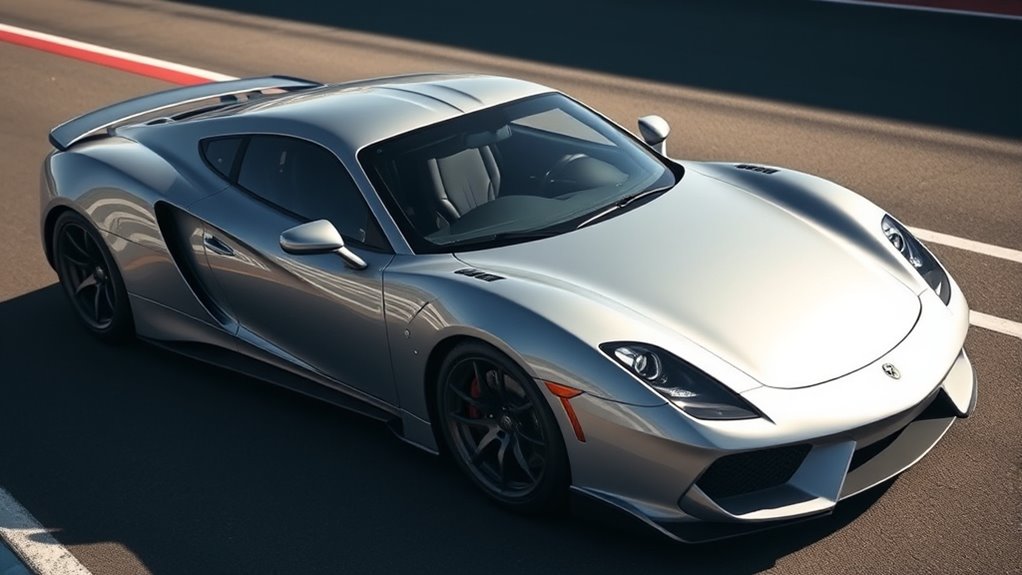
Reducing weight and improving aerodynamics are crucial steps to boost your car’s efficiency and performance. By shedding unnecessary mass and optimizing airflow, you enhance acceleration, handling, and fuel economy. Focus on lightweight components such as alloy wheels, hollow sway bars, and aluminum control arms to cut unsprung weight. Strip non-essential interior parts, replace glass with polycarbonate, and install carbon fiber panels to save significant weight. Material substitutions like titanium fasteners and magnesium wheels further reduce mass without sacrificing strength. Aerodynamic modifications, including front splitters, rear diffusers, and underbody paneling, streamline airflow and decrease drag. These upgrades work together to improve efficiency, stability, and overall driving dynamics. Additionally, implementing active aerodynamic elements such as adjustable spoilers can optimize downforce based on driving conditions. Using lightweight materials for various parts ensures minimal weight gain while maintaining durability. To maximize aerodynamic efficiency, consider adding airflow management features like side skirts and vortex generators. Installing lightweight suspension components like coilovers not only reduces weight but also improves handling precision. Swap steel panels for carbon fiber or polycarbonate to significantly cut weight without compromising structural integrity. Install lightweight alloy wheels and titanium nuts to decrease unsprung mass and enhance responsiveness. Add aerodynamic aids like splitters and diffusers to direct airflow effectively and reduce drag, further boosting performance.
Implementing Turbocharger and Compressor Upgrades
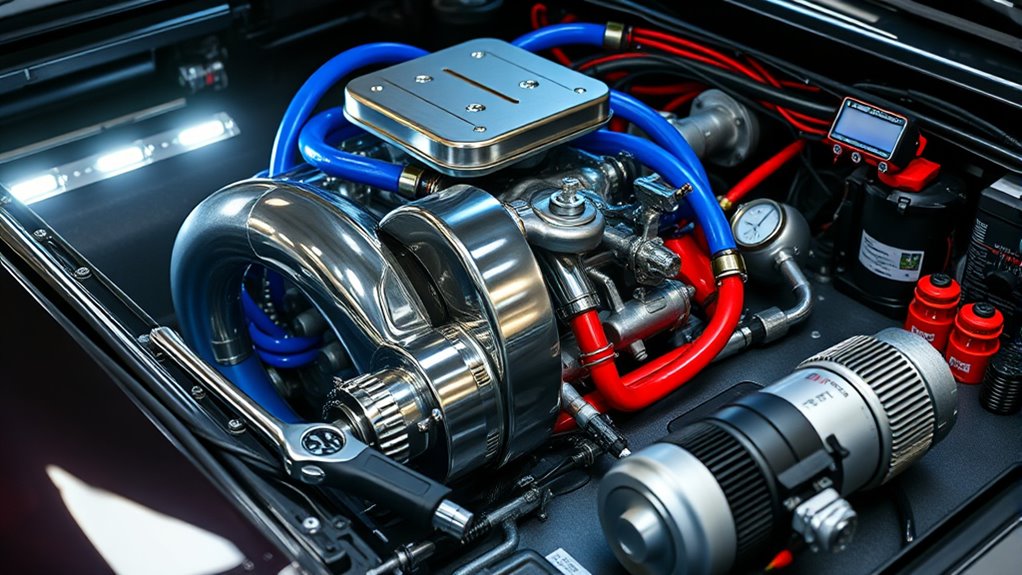
Upgrading your turbocharger and compressor can release significant performance gains when done correctly. First, verify the new turbo matches your engine’s specifications, including compressor wheel size and turbine efficiency. Proper integration with your intake and exhaust systems is essential to maximize benefits and prevent issues like increased backpressure or reduced engine lifespan.
Upgrading to high-performance parts from trusted suppliers like Precision Turbo can boost horsepower, torque, and fuel efficiency. Remember, after installation, tuning is critical—adjust fuel maps and boost levels to optimize performance safely. Proper turbo sizing ensures optimal airflow and compressor map compatibility, which is vital for maintaining engine reliability and achieving the desired power output.
A mismatched turbo can cause engine strain or damage, so precise selection and proper tuning are key. Matching the compressor wheel size to your engine’s airflow demands ensures optimal airflow and compressor map compatibility, these upgrades lead to smoother power delivery, cleaner combustion, and improved overall engine performance. Additionally, understanding the fundamentals of compressor efficiency can help in selecting the right components for your setup.
Regular Maintenance and Testing to Maximize Performance
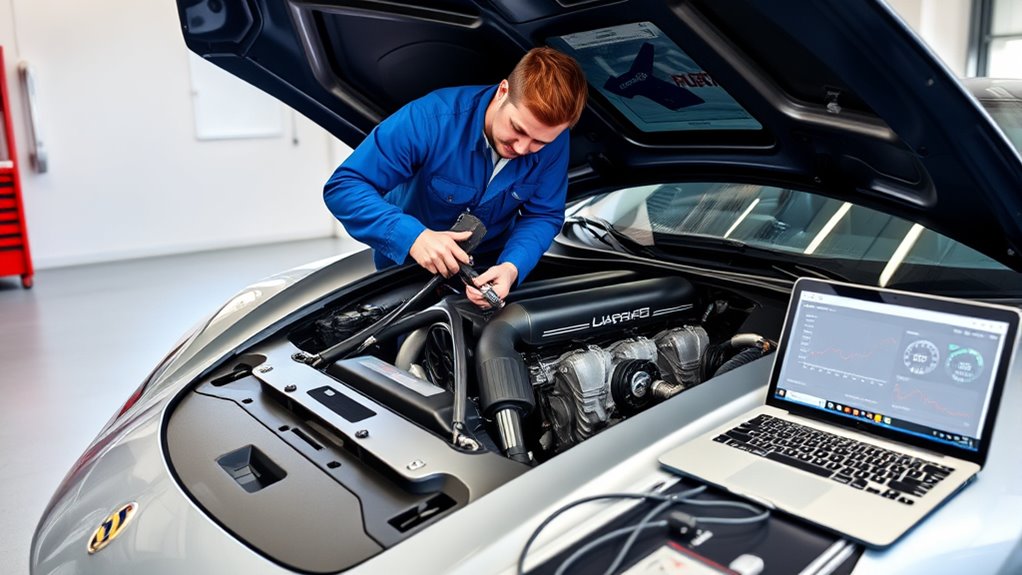
Maintaining your vehicle’s performance relies heavily on consistent upkeep and testing. Regular maintenance ensures all systems operate smoothly, preventing issues that can diminish performance. Stay vigilant with key components to maximize efficiency and power. Regular inspections can identify potential problems early, saving money and preventing breakdowns.
- Check oil levels monthly and top up as needed, replacing oil every 3,000-5,000 miles (conventional) or up to 10,000 miles (synthetic).
- Rotate tires every 5,000-8,000 miles and inspect tread depth quarterly for peak traction.
- Replace air filters annually and clean throttle bodies every 30,000 miles to sustain airflow.
- Inspect spark plugs, ignition coils, and cooling system components regularly to prevent electrical and overheating issues.
Consistent testing and maintenance keep your car running at peak performance, ensuring longevity and reliable power output.
Frequently Asked Questions
How Do I Choose the Right Tuning Modifications for My Specific Car Model?
When choosing tuning modifications for your specific car, start by considering your goals, like racing or daily driving.
Research your car model’s compatibility and available aftermarket parts.
Join tuning communities for advice and insights.
Prioritize upgrades that match your budget and desired performance, focusing on engine, suspension, and braking improvements.
Always verify parts are compatible with your vehicle’s generation, and plan for maintenance and testing to optimize results.
What Are the Risks of Over-Tuning or Improper Tuning Practices?
You might think over-tuning boosts your car’s power, but it actually risks serious damage. Improper tuning can void warranties, cause engine wear, and lead to transmission failures.
It may also trigger emissions violations and legal fines. Poorly calibrated tunes can cause engine knocking, overheating, or even bricking your ECU.
Always guarantee your tuning practices are precise and professional to avoid these costly, dangerous issues and keep your car running smoothly.
Can Tuning Negatively Impact My Vehicle’s Reliability or Lifespan?
Tuning can negatively impact your vehicle’s reliability and lifespan if done improperly or aggressively. You might experience increased wear on engine parts, faster component failure, or engine stress, especially if the tune isn’t correctly calibrated.
Poor tuning can lead to reliability issues and early engine failure. To avoid this, verify you have a professional tune, follow recommended maintenance, and drive responsibly, minimizing strain on your car’s components.
How Do I Ensure My Tuning Modifications Comply With Local Emissions Laws?
You’re steering through a legal minefield when it comes to emissions laws, so it’s vital to stay on the right side of the law. First, check your local regulations and make sure your modifications meet CARB and EPA standards.
Use compliant tuning tools, avoid tampering, and consult professionals who understand emissions compliance. Regularly test your vehicle and keep documentation up-to-date, so your car runs smoothly without legal bumps in the road.
What Tools or Software Are Recommended for DIY Car Tuning?
When choosing tools for DIY car tuning, you should consider ECU reflashing software like TOAD PRO or Viezu, which let you adjust engine parameters via your laptop.
Standalone devices such as My Genius or New Genius Touch simplify the process without needing a computer.
Essential physical tools include wideband AFR meters, timing lights, and multimeters. These tools help you safely and effectively optimize your vehicle’s performance while ensuring ease of use.
Conclusion
With every tweak and upgrade, you transform your car into a roaring beast ready to conquer the road. Imagine the thrill of accelerated power, the precision of sharp handling, and the sleek glide through wind and curves. By tuning your ride carefully, you’re not just driving—you’re commanding the asphalt beneath you. So, get hands-on, stay vigilant with maintenance, and watch your car’s performance soar, turning every drive into an exhilarating experience.




